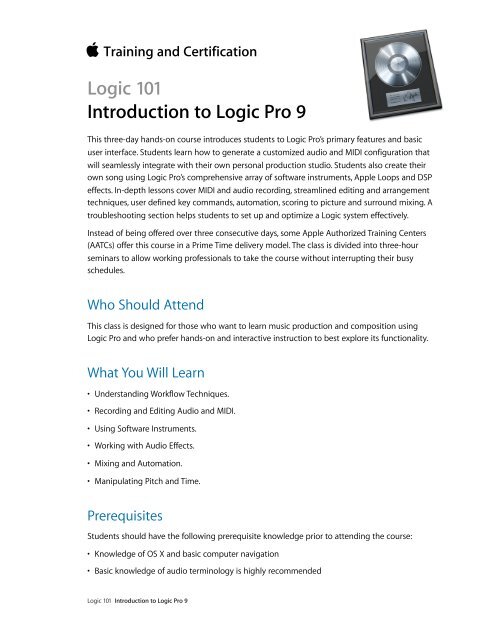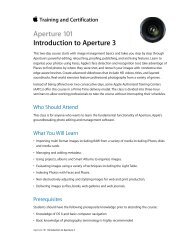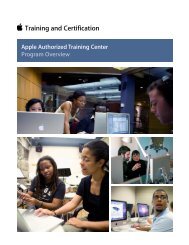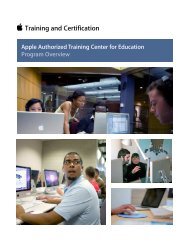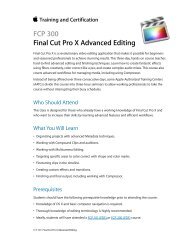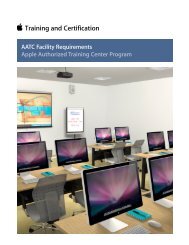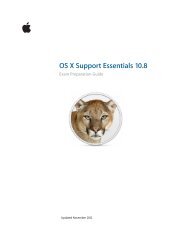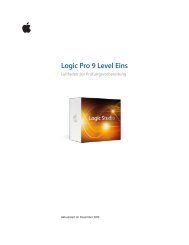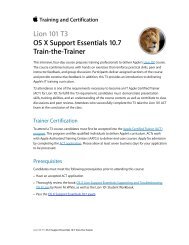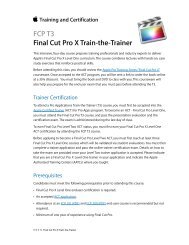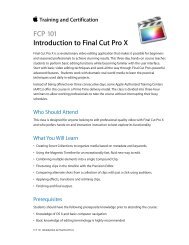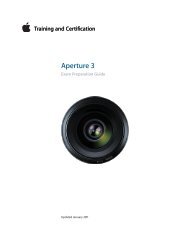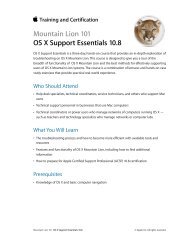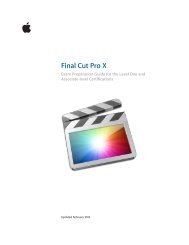Logic 101: Introduction to Logic Pro 9 (PDF) - Training - Apple
Logic 101: Introduction to Logic Pro 9 (PDF) - Training - Apple
Logic 101: Introduction to Logic Pro 9 (PDF) - Training - Apple
You also want an ePaper? Increase the reach of your titles
YUMPU automatically turns print PDFs into web optimized ePapers that Google loves.
<strong>Training</strong> and Certification<br />
<strong>Logic</strong> <strong>101</strong><br />
<strong>Introduction</strong> <strong>to</strong> <strong>Logic</strong> <strong>Pro</strong> 9<br />
This three-day hands-on course introduces students <strong>to</strong> <strong>Logic</strong> <strong>Pro</strong>’s primary features and basic<br />
user interface. Students learn how <strong>to</strong> generate a cus<strong>to</strong>mized audio and MIDI configuration that<br />
will seamlessly integrate with their own personal production studio. Students also create their<br />
own song using <strong>Logic</strong> <strong>Pro</strong>’s comprehensive array of software instruments, <strong>Apple</strong> Loops and DSP<br />
effects. In-depth lessons cover MIDI and audio recording, streamlined editing and arrangement<br />
techniques, user defined key commands, au<strong>to</strong>mation, scoring <strong>to</strong> picture and surround mixing. A<br />
troubleshooting section helps students <strong>to</strong> set up and optimize a <strong>Logic</strong> system effectively.<br />
Instead of being offered over three consecutive days, some <strong>Apple</strong> Authorized <strong>Training</strong> Centers<br />
(AATCs) offer this course in a Prime Time delivery model. The class is divided in<strong>to</strong> three-hour<br />
seminars <strong>to</strong> allow working professionals <strong>to</strong> take the course without interrupting their busy<br />
schedules.<br />
Who Should Attend<br />
This class is designed for those who want <strong>to</strong> learn music production and composition using<br />
<strong>Logic</strong> <strong>Pro</strong> and who prefer hands-on and interactive instruction <strong>to</strong> best explore its functionality.<br />
What You Will Learn<br />
• Understanding Workflow Techniques.<br />
• Recording and Editing Audio and MIDI.<br />
• Using Software Instruments.<br />
• Working with Audio Effects.<br />
• Mixing and Au<strong>to</strong>mation.<br />
• Manipulating Pitch and Time.<br />
Prerequisites<br />
Students should have the following prerequisite knowledge prior <strong>to</strong> attending the course:<br />
• Knowledge of OS X and basic computer navigation<br />
• Basic knowledge of audio terminology is highly recommended<br />
<strong>Logic</strong> <strong>101</strong> <strong>Introduction</strong> <strong>to</strong> <strong>Logic</strong> <strong>Pro</strong> 9
Course Outline<br />
Day 1<br />
Make Music with <strong>Logic</strong> <strong>Pro</strong><br />
Opening <strong>Logic</strong>, Exploring the Interface, Starting a <strong>Pro</strong>ject with <strong>Apple</strong> Loops, Navigating the<br />
<strong>Pro</strong>ject, Building an Arrangement, Mixing the Song, and Exporting the Mix<br />
Recording Audio<br />
Setting Up Digital Audio Recording Settings, Recording a Single Track, Recording Additional<br />
Takes, Recording Multiple Tracks, Punching In and Out (On the Fly and Au<strong>to</strong>matic), Changing<br />
Recording and Metronome Settings<br />
Editing Audio<br />
Comping Takes, Assigning Mouse Tools, Editing Audio Regions in the Arrange Area, Deleting<br />
Unused Audio Files, Manipulating the Waveform with the Flex Tool and Editing Audio<br />
Destructively in the Sample Edi<strong>to</strong>r<br />
Day 2<br />
Recording MIDI<br />
Recording MIDI, Quantizing MIDI Recordings, Merging Recordings in<strong>to</strong> a MIDI Region, Recording<br />
MIDI Takes, Using Punch Recording, Using Step Input Recording and Filtering Incoming MIDI<br />
Events<br />
<strong>Pro</strong>gramming and Editing MIDI<br />
<strong>Pro</strong>gramming in the Piano Roll Edi<strong>to</strong>r, Editing a MIDI Recording, Using the Score Edi<strong>to</strong>r, Editing<br />
Notes with a MIDI Keyboard, Editing Note Velocity Using Hyper Draw, Editing MIDI Continuous<br />
Controller Events and Editing in the Event List<br />
<strong>Pro</strong>gramming Drums<br />
<strong>Pro</strong>gramming a Drum Pattern in Ultrabeat, Changing the Groove in the MIDI Edi<strong>to</strong>rs, Creating a<br />
Snare Roll Using the Hyper Edi<strong>to</strong>r, Converting a MIDI Sequence in<strong>to</strong> an Audio Region and<br />
Converting an Audio Region in<strong>to</strong> a Sampler Instrument Track<br />
Manipulating Tempo and Time Stretching<br />
Matching the <strong>Pro</strong>ject Tempo <strong>to</strong> an Audio Region’s Tempo, Inserting Tempo Changes and Curves,<br />
Creating <strong>Apple</strong> Loops, Changing the Playback Pitch and Speed with Varispeed, Time Stretching<br />
and Tempo Matching with Flex Time Editing and Creating a Turntable or Tape Slowdown Effect<br />
Arranging and Preparing for the Mix<br />
Previewing the Song, Using Existing Material <strong>to</strong> Fill in Parts, Adding and Deleting Sections,<br />
Muting Elements and Cleaning Up Noisy Recordings<br />
<strong>Logic</strong> <strong>101</strong> <strong>Introduction</strong> <strong>to</strong> <strong>Logic</strong> <strong>Pro</strong> 9
Day 3<br />
Mixing<br />
Previewing the Final Mix, Using the Amp Designer, Using the Pedalboard, Adjusting Levels,<br />
Choosing Pan Positions, Choosing EQ Settings, Using Delay and Reverberation, Using Dynamic<br />
<strong>Pro</strong>cessing Plug-ins and Tips and Tricks<br />
Au<strong>to</strong>mating the Mix and Using Control Surfaces<br />
Creating and Editing Offline Au<strong>to</strong>mation, Recording Live Au<strong>to</strong>mation, Using Control Surfaces<br />
and Exporting the Mix<br />
Troubleshooting and Optimization<br />
Making Backups, Solving Audio and MIDI Routing <strong>Pro</strong>blems, Optimizing Hardware Performance<br />
and Addressing Unexpected Behaviors<br />
Certification Exam<br />
Students take an end user exam <strong>to</strong> earn <strong>Apple</strong> Certified <strong>Pro</strong>, <strong>Logic</strong> <strong>Pro</strong> 9 Level One status.<br />
How <strong>to</strong> Register<br />
Check the course schedule for a list of courses available for registration at <strong>Apple</strong> Authorized<br />
<strong>Training</strong> Centers worldwide.<br />
Build Credibility. Get Certified.<br />
• Demonstrate your knowledge by passing the <strong>Logic</strong> <strong>Pro</strong> 9 Level One exam and earning <strong>Apple</strong><br />
Certified <strong>Pro</strong> - <strong>Logic</strong> <strong>Pro</strong> 9 Level One certification.<br />
• <strong>Apple</strong> Authorized <strong>Training</strong> Centers offer exams either as part of the course or separately.<br />
Learning Options<br />
The book for this course is <strong>Apple</strong> <strong>Pro</strong> <strong>Training</strong> Series, “<strong>Logic</strong> <strong>Pro</strong> 9 and <strong>Logic</strong> Express 9” by David<br />
Nahmani. Save 30% by using coupon code PP-APL-DISC. Click here for availability in other<br />
languages.<br />
<strong>Logic</strong> <strong>101</strong> <strong>Introduction</strong> <strong>to</strong> <strong>Logic</strong> <strong>Pro</strong> 9


